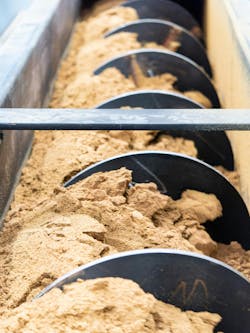How material properties determine the optimal bulk solid conveyor: Part 2
June 24, 2024
4 min read
Photo 235230101 © Thor Jorgen Udvang | Dreamstime.com

Many types of conveying systems are available for powders and bulk solids. The material’s characteristics will often determine the best type of conveying system for a particular application. Understanding the material’s properties will help processors rule out some conveyors and choose which types will work well.
Friability
If minimizing particle damage is important, avoid conveyors that cause rubbing, crushing, or impact, especially at high velocity. Fragile materials are often conveyed without damage in tubular drag conveyors that push material slowly through a tube. A controlled feed into the tubular drag conveyor is important, so vibratory feeders are often used as the feed device. Dense-phase pneumatic conveying is also characterized by slow velocity and works well with some materials, especially if the particles are uniform in size and shape.
Standard pneumatic conveying, called dilute-phase conveying, can be harmful because the material moves at high velocity through the pipe and then impacts elbows and receivers. If the conveyor layout will be relatively flat and unidirectional, then belt conveyors are ideal since the material lies on the belt without impact or crushing.
Feeders such as airlock rotary valves and screw conveyors can crush or shear material between the rotating piece and the stationary housing. Anti-shearing devices can help reduce shearing at the inlet, but they generally only work well for uniform materials that flow easily. Vibratory feeders, as previously mentioned, are a good choice.
Abrasiveness
Highly abrasive materials are not a good match for conveyors in which the materials rub against the equipment, especially at high velocities. Consider conveyors, such as belt conveyors, in which the material and conveyor move together. Low-velocity dense-phase pneumatic conveying suits materials with uniform particle size and shape. Some other types of conveyors, including screw conveyors, drag conveyors, and dilute-phase pneumatic conveyors, will experience more wear, but abrasive-resistant options are available. Such abrasive-resistant options are expensive but may pay off with reduced downtime and maintenance.
Abrasiveness is measured with a custom lab device that rubs material against a substrate with a controlled force and speed; it measures how much wear occurs over an accelerated time period. This type of testing is valuable when evaluating the relative wear resistance of various metals, plastics, or coatings. And it can reliably compare the abrasiveness of various bulk solid materials.
Flowability and cohesiveness
Whether the material flows easily or sticks to other particles or equipment and sidewalls will help dictate not only the conveyor type but also how to get the material into and out of the conveyor. Flowability measurements can determine minimum hopper angles, discharge opening sizes, and the best flow aid devices. If the material becomes more cohesive with humidity or temperature, many conveyors will work well only if the area is kept dry and cool. Non-stick materials of construction or coatings can help many conveyors. Even so, equipment such as screw conveyors, bucket elevators, and rotary valves that move a device through the material may not work without frequent cleaning. Conveyors with smooth surfaces, such as belts and pneumatic conveying, often work better.
Flowability is most often measured with shear testing, which measures how easily particles flow past one another, and wall friction testing, which measures how easily particles flow past a surface.
Small sample or full-scale conveying test?
As described above, tests using small material samples and the correct bench instruments can answer most questions and help achieve the best conveying system design. As with any testing, proper interpretation of the lab results is critical.
However, full-scale testing may be required, particularly if the aspect is critical or scale-up to production is challenging. Stickiness and cleanability are difficult to predict without full-scale testing. Moreover, if particle breakage is paramount, then full-scale testing is often the best way to choose and verify the optimal conveying option. To evaluate breakage, send material samples to a full-scale lab or the equipment supplier and ask them to run the material through their system. Evaluation typically involves measuring particle size before and after the test. Another benefit of testing is that it is the best way to recommend features, sizes, and speeds that will work well for the application.
Many equipment and system suppliers will perform tests for free or at a modest charge if you plan to buy equipment from them. Other labs, such as K-State's Bulk Solids Technology Center, have a wider variety of test equipment and can perform independent testing for a reasonable fee.
About the Author

Todd Smith
Todd Smith has helped manage Kansas State University's Bulk Solids Technology Center since 2019. KSU-BSTC (https://bulk-solids.k-state.edu) is the only university-centered facility and staff in North America dedicated to helping industry with bulk solid challenges and education. Previously, Todd spent his nearly forty-year career in industry working with bulk solids — first at four DuPont plants, then at Mac Equipment (now Schenck Process) and Coperion K-Tron. Todd is also a member of Processing’s editorial advisory board.
Sign up for our eNewsletters
Get the latest news and updates